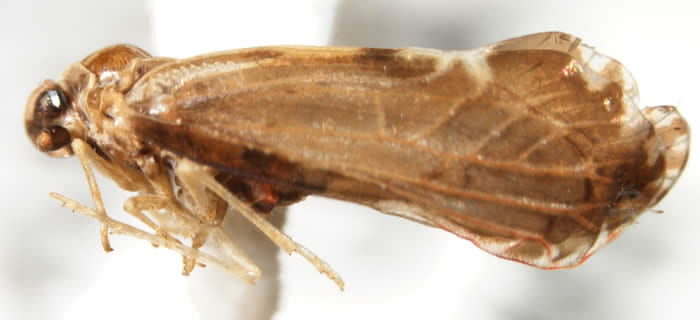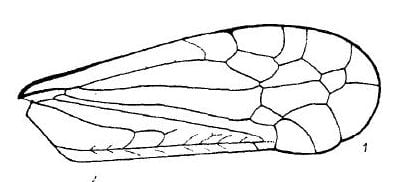[Back to North American Derbidae]
Key to New World Genera of Cenchreini (sensu Fennah 1952) from O’Brien (1982)
Note: Cenchreini is a tribe of Derbinae; O’Brien’s key was based on Fennah (1952) and includes taxa now moved to other groups (e.g., by Emeljanov, 1992), noted below. This key needs to be revised to include Agoo, and some of the wing features are obscure.
Fennah (1952) used the following features to diagnose Cenchreini in his key:
A. Tegmina with clavus (usually) open; (at least) second cubital vein not reaching hind margin directly but curving into subapical transverse line of cross-veins; often, but not invariably, common claval vein extending through open claval apex to join subapical transverse lines; frons usually strongly compressed … Tribes Zoraidini, Sikaianini, Otiocerini (inc. Nicertini), Rhotanini
A’ Tegmina with clavus (usually) closed; second cubital vein reaching hind margin directly (or meeting transverse veinlets more or less rectangularly, transverse veinlets usually reaching hind margin); frons narrow, usually not strongly compressed … B (Derbini and Cenchreini sensu Fennah 1952)
B Tegmina with clavus not more than half as long as the whole tegmen; M and Cu with not less than 8 branches at the margin; [hind] wings not more than half as long as tegmina … Derbini
B’ Clavus at least half as long as whole tegmen; M and Cu usually with less than 8 branches at the margin; [hind] wings more than half as long as tegmina … Cenchreini
Figure 6 from Emeljanov 1996 (English version of 1995); Dawnarioides was considered Cenchreini by Fennah 1952 but moved into a new tribe (Dawnarioidini) by Emeljanov 1996
Figure 2 from Fennah (1952); Mula is in Sikaianini.
Figure 10 from Emeljanov 1996
Figure 11 from Emeljanov 1996
Key to New World Cenchreini (after O’Brien 1982 modified from Fennah 1952)
Under revision; some of the venation features used here are doubtful, seeking specimens of some genera to assess features of the head and pygofer)
1- Subantennal process of gena well developed; pustules absent on wings … Cedusa Fowler (now Breddiniolinae: Cedusini)
1’- Subantennal process of gena absent or very small; pustules often present along claval veins and sometimes also along costal vein or Sc+R … 2
2(1’)- Lateral carinae of vertex pustulate; paradiscal region of pronotum (i.e., lateral portions) foliate and forming antennal foveae (except in Persis (Eritalaena) fuscinervis Muir) … 7 (Cenchreini)
2’- Lateral carinae of vertex not markedly pustulate; antennal fovea lacking … 3 (not Cenchreini)
3(2’)- Frons strongly laterally compressed, lateral carinae meeting medially (Figs. 3, 5, 7, 9); head broadly rounded anteriorly in lateral view (Fig. 10) … 4
3’- Frons not laterally compressed, lateral carinae widely separated; vertex angulate with frons, head not rounded anteriorly in lateral view … 6
4(3)- Anterior claval veins markedly pustulate; male with antennae flattened and exceeding the length of head … Patara Westwood (Patarini: Otiocerinae)
4’- Anterior claval veins not pustulate; antennae shorter than head … 5
5(4’)- Cu2 connected to apex of clavus by crossvein (Fig. 2); in frontal view pronotum 2x or more wide than high (height measured dorsoventrally from ventral most part of pronotum) (Fig. 3, 5, 7, 9) … Neodawnaria O’Brien, 1992 (Derbinae: Dawnarioidini)
5’- Cu2 not connected to apex of clavus by crossvein; in frontal view pronotum less than 2x as wide as high (Fig. 11, 13) … Dawnarioides Dozier (Derbinae: Dawnarioidini)
6(3’)- Frons subrectangular; vertex without median carina … Goneokarella Fennah (Cedusinae: Goneokarellini)
6’- Frons subtriangular; vertex with median carina … lpsnola Signoret (Cedusinae: Ipsnolini)
7(2)- Frons moderately broad, flat or slightly convex in dorsal view, not at all concave … Oropuna Fennah or Herpis Stal … 8
7’- Frons not as above… 9 (e.g., Cenchrea Westwood, Contigucephalus Caldwell, Cenanges Fennah, Neocenchrea Metcalf, Persis Stal, Omolicna Fennah, Agoo Bahder & Bartlett, Anchimothon Fennah, or Phaciocephalus Kirkaldy)
8(7)- Frons with median carina; medioventral lobe of pygofer rounded … Herpis Stal
8’- Frons lacking median carina; medioventral lobe of pygofer subquadrate … Oropuna Fennah
9(7’)- Lateral pronotal carinae and ventral lateral margins of pronotum not foliately raised … Persis Stal subgenus (Eritalaena) Fennah
9’- Lateral pronotal carinae and ventral lateral margins laminate, forming a subantennal fovea … 10
10(9’)- Tegmina with subcostal cell short (not extending basad of claval apex); frons very narrow; a fine transverse carina between vertex and frons; pronotum with a distinct medial disc bounded by carinae … 11
10’- Tegmina with subcostal cell long, no demarcated pronotal disc … 12
11- Medioventral process present on pygofer … Cenchrea Westwood
11’- Medioventral process reduced … Contigucephalus Caldwell
12- Tegmina with Sc+R fork distad of Cu1 fork, latter about level with union of claval veins … 13
12’- Tegmina with Sc+R fork basad of Cu1 fork, latter about level with claval apex … 14
13(12)- Tegmina with papillate portion of anterior margin equal to smooth basal portion (node medial); pygofer with no medioventral process … Neocenchrea Metcalf
13’- Tegmina with papillate portion of anterior margin distinctly shorter than smooth basal portion (node distad of middle); pygofer with a medioventral process … Persis Stal subgenus Anapersis Fennah
14 (12’)- Apex of clavus distad of middle of tegmen … 15
14’- Apex of clavus at middle of tegmen; head compressed, but not linear; frons widest at distal border … Cenanges Fennah
(Agoo keys to here, apex of the clavus slightly past midlength of wing; head compressed; median process of pygofer rounded, longer than wide)
15 (14)- Frons in middle line at least 3 times as long as broad at widest part; anal segment of male very long and narrow … Anchimothon Fennah
15’- Frons relatively shorter; anal segment of male not as above … 16
16 (15’)- Frons in middle line more than 2 times as long as broad at the widest part, tegmina with first M fork basad of claval apex … Phaciocephalus Kirkaldy (genus is mostly Old World but includes 3 species from Brazil, probably misplaced to genus)
16’- Frons in middle line less than 2 times as long as broad at, widest part, tegmina with first M fork at level of claval apex … Omolicna Fennah
Critical Literature
Emeljanov, A. F. 1995. K voprosu o sistemie i filogenii sem. Derbidae (Homoptera, Cicadina) [On the System and Phylogeny of the Family Derbidae (Homoptera, Cicadina)]. Entomologicheskoe Obozrenie (1994) 73(4): 783-811 (in Russian, translated to English in Entomological Review 1996 75(2): 70-100).
Emeljanov, A. F. 1992. Two new tribes, a new genus and a new species of the family Derbidae (Homoptera, Fulgoroidea). Vestnik Zoologii 4: 19-23. [In Russian]
Fennah, R. G. 1952. On the generic classification of Derbidae (Homoptera: Fulgoroidea) with descriptions of new Neotropical species. Transactions of the Royal Entomological Society of London 103(4): 109-170.
O’Brien, L. B. 1982. Two Neotropical derbid genera with observations on wing rolling (Fulgoroidea: Homoptera). Florida Entomologist 65(3): 306-321.



































